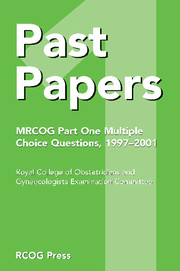Book contents
- Frontmatter
- Contents
- Introduction
- March 1997 – Paper 1
- March 1997 – Paper 2
- September 1997 – Paper 1
- September 1997 – Paper 2
- March 1998 – Paper 1
- March 1998 – Paper 2
- September 1998 – Paper 1
- September 1998 – Paper 2
- March 1999 – Paper 1
- March 1999 – Paper 2
- September 1999 – Paper 1
- September 1999 – Paper 2
- March 2000 – Paper 1
- March 2000 – Paper 2
- September 2000 – Paper 1
- September 2000 – Paper 2
- March 2001 – Paper 1
- March 2001 – Paper 2
- September 2001 – Paper 1
- September 2001 – Paper 2
- Index
March 1999 – Paper 1
Published online by Cambridge University Press: 05 July 2014
- Frontmatter
- Contents
- Introduction
- March 1997 – Paper 1
- March 1997 – Paper 2
- September 1997 – Paper 1
- September 1997 – Paper 2
- March 1998 – Paper 1
- March 1998 – Paper 2
- September 1998 – Paper 1
- September 1998 – Paper 2
- March 1999 – Paper 1
- March 1999 – Paper 2
- September 1999 – Paper 1
- September 1999 – Paper 2
- March 2000 – Paper 1
- March 2000 – Paper 2
- September 2000 – Paper 1
- September 2000 – Paper 2
- March 2001 – Paper 1
- March 2001 – Paper 2
- September 2001 – Paper 1
- September 2001 – Paper 2
- Index
Summary
1. In the pituitary gland
A. the anterior lobe is smaller than the posterior lobe.
B. the posterior lobe is ectodermal in origin.
C. the acidophil cells produce oxytocin.
D. the basophil cells produce growth hormone.
E. the blood supply is derived from the internal carotid artery.
2. The following statements concerning the pelvic vessels are correct:
A. The inferior gluteal artery passes through the greater sciatic foramen.
B. The inferior vesical artery supplies the fundus of the bladder.
C. The middle rectal artery supplies the rectal mucosa.
D. The uterine venous plexus communicates with the rectal plexus.
E. The vesical venous plexus drains into the external iliac artery.
3. The obturator artery
A. branches from the posterior trunk of the internal iliac artery.
B. passes through the greater sciatic foramen.
C. is crossed by the ureter.
D. supplies the hip joint.
E. may be replaced by a branch of the superior epigastric artery.
4. The obturator nerve
A. arises from the sacral plexus.
B. descends through the psoas major muscle.
C. leaves the pelvis through the greater sciatic foramen.
D. mainly supplies the abductor muscles of the thigh.
E. innervates the obturator internus muscle.
5. The pelvic splanchnic nerves
A. supply the ascending colon.
B. contribute to the inferior hypogastric plexus.
C. are motor to the internal sphincter of the bladder.
D. contain afferent fibres for the ovary.
E. conduct pain from the body of the uterus.
- Type
- Chapter
- Information
- Past Papers MRCOG Part One Multiple Choice Questions1997–2001, pp. 81 - 90Publisher: Cambridge University PressPrint publication year: 2004



